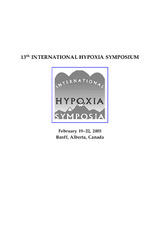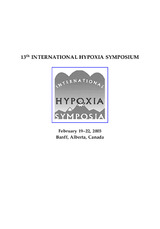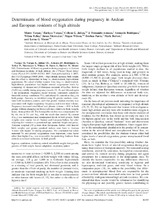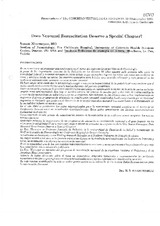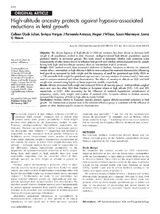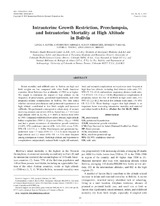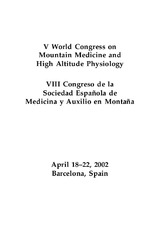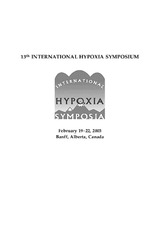Listar por autor "Niermeyer, Susan"
Mostrando ítems 1-12 de 12
-
Andean compared with european women are protected from altitude-associated intrauterine growth restriction (IUGR)
Moore, Lorna G; Armaza, Fernando; Keyes, L; Borth, R; Niermeyer, Susan; Villena, Mercedes; MacCannell, Wendy; Vargas, Enrique (s.n., 2003)Abstract. Babies born at high altitude to long-term high-altitude residents weigh more than those of recent migrants from low altitude. Objective: We asked whether a gradient exists such that persons of Andean ancestry ... -
Andean women have greater uterine artery (UTA) enlargement during pregnancy than european residents of 3600 m.
Moore, Lorna G; Wilson, Megan; López, Miriam; Vargas, Marco; Parra, Esteban; Niermeyer, Susan; Aramaza, J Fernando; Vargas, Enrique ([s.n.], 2003)Abstract. Babies weigh less at high altitude but multi-generational high-altitude residents are protected from this birth weight decline (Moore HAMB 2001). Objective: We asked if higher arterial oxygenation and/or blood ... -
Determinants of blood oxygenation during pregnancy in Andean and Europeas residents of high altitude
Vargas, Marco; Vargas, Enrique; Julian, Colleen Glyde; Armaza, J Fernando; Rodríguez, Armando; Téllez, Wilma; Niermeyer, Susan; Wilson, Megan; Parra, Esteban; Shriver, Mark; Moore, Lorna G (Am J Physiol Regul Integr Comp Physiol, 2007-07-02)High altitude decreases birth weight, but this effect is diminished in long vs. short-resident, high-altitude populations. We asked whether women from long vs. short-resident, high-altitude populations had higher arterial ... -
Does chronic mountain sickness (CMS) have perinatal origins?
Moore, Lorna G; Niermeyer, Susan; Vargas, Enrique (Respiratory Physiology & Neurobiology, 2007-06-29)Abstract. Chronic mountain sickness (CMS) occurs in 10% of male high-altitude residents. It is characterized by hypoventilation and hypoxemia but its underlying cause remains unknown. We hypothesized that CMS' origins ... -
Does neonatal resuscitation deserve a special chapter?
Niermeyer, Susan (Segundo Congreso Virtual de Cardiología, 2001-11)Neonatal resuscitation has developed into a distinct sub-discipline of pediatric resuscitation, which itself stands apart from adult cardiopulmonary resuscitation. What justifies this ... -
Greater uterine artery blood flow during pregnancy in multigenerational (Andean) than shorter-term (European) high-altitude residents
Wilson, Megan J; López, Miriam; Vargas, Marco; Julian, Colleen Glyde; Téllez, Wilma; Rodríguez, Armando; Bigham, Abigail; Armaza, J Fernando; Niermeyer, Susan; Shriver, Mark; Vargas, Enrique; Moore, Lorna G (Am J Physiol Regul Integr Comp Physiol, 2007)Multigenerational (Andean) compared with shorter-term (European) high-altitude residents exhibit less hypoxia-associated reductions in birth weight. Because differences in arterial O2 content are not responsible, we ... -
High-altitude ancestry protects against hypoxia-associated reductions in fetal growth
Julian, Colleen Glyde; Vargas, Enrique; Armaza, J Fernando; Wilson, Megan J; Niermeyer, Susan; Moore, Lorna G (Archives of Disease in Childhood-Fetal and Neonatal, 2007-02-28)Objective: The chronic hypoxia of high-altitude (>2500 m) residence has been shown to decrease birth weight in all populations studied to date. However, multigenerational high-altitude populations appear protected relative ... -
Intrauterine growth restriction, preeclampsia, and intrauterine mortality at high altitude in Bolivia
Keyes, LE; Armaza, Fernando; Niermeyer, Susan; Vargas, Enrique; Young, David A; Moore, Lorna G (PEDIATRIC RESEARCH, 2003-02-18)Abstract. Infant mortality and stillbirth rates in Bolivia are high and birth weights are low compared with other South American countries. Most Bolivians live at altitudes of 2500 m or higher. We sought to determine the ... -
Neonatal oxygenation, pulmonary hypertension, and evolutionary adaptation to high altitutde (2013 Grover Conference series)
Niermeyer, Susan; Andrade-M, Mario Patricio; Vargas, Enrique; Moore, Lorna G (Pulm Circ, 2015-03)Abstract. Andeans and Tibetans have less altitude reduction in birth weight than do shorter-resident groups, but only Tibetans are protected from pulmonary hypertension and chronic mountain sickness (CMS). We hypothesized ... -
Postnatal changes in the pulmonary circulation at 3700-4000 m
Niermeyer, Susan; Andrade, Patricio; Moore, Lorna G (High Altitude Medicine & Hygiene, 2002-04-18)Objective: The hypoxia of high altitude can impair postnatal changes in the pulmonary circulation. We documented pulmonary artery pressures (PPA) and persistence of fetal circulatory patterns among infants born at 3700–4000m ... -
Reduced endothelin-1 (ET-1) and elevated nitric oxide metabolites (NOX) across pregnancy among andean vs. european women at high (3100-3600 m) altitude
Julian, Colleen Glyde; Wilson, Megan; Vargas, Enrique; Vargas, Marco; López, Miriam; Niermeyer, Susan; Moore, Lorna G (High Altitude Medicine & Biology, 2005-02-22)Background. A consistent reduction in infant birth weight occurs with ascending altitude; however multigenerational high-altitude residents [Andeans] demonstrate a degree of protection from altitude-associated IUGR ... -
Uterine artery blood flow during pregnancy in high-altitude aymara women
Wilson, Megan; Niermeyer, Susan; Armaza, J Fernando; López, Miriam; Vargas, Enrique; Moore, Lorna G (High Altitude Medicine & Biology, 2003-02-19)Background. Birth weight falls with increasing altitude as the result of intrauterine growth restriction (IUGR) likely due, in turn, to lower uterine artery (UtA) blood flow. The altitude-associated birth weight decline is ...

